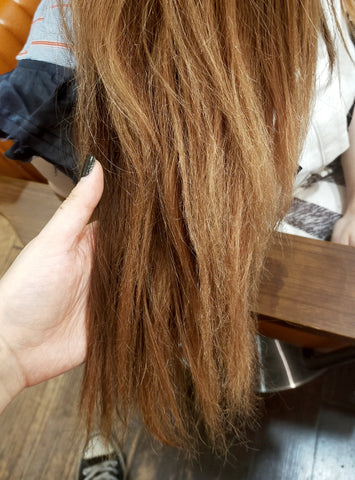NO BLEACH, NO LIFE!
A Stylist’s Guide to Coloring


Fast Facts
-
(+) unique colors, easier to style
-
(--) lost moisture, weaker hair
-
Hydrogen peroxide
-
Oxidation = swells hair, dissolves color (melanin)
-
Max 2x/day, 3x if short hair
-
Don’t wash before
Bleaching is a popular service at Japanese hair salons. While we love beautiful colors, here are a few things you should consider before you bleach.
How it works
Bleaching is a “coloring service” that breaks down your hair’s melanin.
To make your hair lighter you have to use a bleaching/oxidizing agent, usually hydrogen peroxide.
The agent penetrates the cortex and dissolves the hair’s natural pigments (melanin) via oxidation; it will go through several levels depending on your natural pigment and base color.
*Porosity: ability to absorb and retain moisture.
After your hair is bleached it will be easier to style, but the hair’s shine will be compromised and the strand will be weakened.
Before you bleach
Ask your stylist how many levels (Lv) to raise your hair, then decide on bleach strength. “We’ll need to bleach twice” means your hair is stiff and/or rich with red melanin.

The longer you leave in a bleaching agent, the lighter your hair will become. After a certain amount of time the bleach will only cause damage, so you’ll need to rinse + reapply.



Don’t wash your hair before bleaching; it might sting if your scalp is dry or lacks oil. Scalp damage increases in dry seasons, like winter, so assess your scalp before treatment.
Coloring
We set the maximum bleaching to 2x/day (short hair, 3x/day). You can bleach more, but the damage will hurt the overlaid color.


▲4 times bleached hair ( brakeage )
Most unique colors (over 16Lv) require a bright hair base to work; semi-permanent dyes can’t lighten hair.


Sometimes you need to remove your current color before adding a new one. Returning your hair to its natural color isn’t difficult, but dark pigments are harder to remove.
Previously lightened hair is fragile and sometimes unable to be re-bleached.
At Number76 Tokyo we only bleach as much as needed and have top products for restoring dry or damaged hair.
Don't despair; let's repair!

Hair care
FIBREPLEX FOR HAIR PROTECTION
"Fibreplex" strengthens your hair and protects it from damage.

Hair is made up of polypeptides bound with amino acids, and healthy hair is unified by these internal tissue bonding. Fibreplex strengthens the hair by protecting and rebuilding these connections.

Dicarboxylic acid, which is the main component of Fibreplex, penetrates the hair and firmly adheres to the fibers inside, protecting the hair from bleach, color and permanent damage. Furthermore, by coating the surface of the hair, the dicarboxylic acid makes your hair appear glossy and the effect lasts longer.
Fibreplex Shampoo / treatment ¥1,100
Use for 3 consecutive days after bleaching at the salon, and then once or twice a week.
APPLY A HEAT-PROTECTANT WHEN STYLING
After bleaching, your hair’s cuticle will be compromised and your hair will be prone to moisture evaporation. Heat protectant serums will help shield your hair from moisture evaporation when using heated tools, including blow-dryers and curlers.
USE A DAILY SHIELD
Apply a lightweight, protective spray or serum throughout the day. These products will help keep your strands hydrated, shiny and shielded from environmental damage like air conditioning, wind, friction and UV rays. It will also shield your cuticle from further harm.
INVEST IN A GOOD CONDITIONER
Global MILBON treatment
BRUSH GENTLY
To help prevent breakage, gently detangle your hair, starting from the ends and gradually working up to your roots. When you brush your hair, it is better if the hair is totally dry. Do not pull too hard or your hair will snap.





